Accounting Analysis of Larson and Dynamic Contract: Finance Case
VerifiedAdded on 2023/06/11
|14
|3009
|143
Case Study
AI Summary
This case study analyzes the accounting issues within Larson and Dynamic Contract, focusing on the appropriate application of GAAP for software development costs, capitalization versus expensing of costs, and amortization of the CRM system. The report addresses the ethical considerations, decision-making processes, and measurement analysis involved in accounting for the CRM system. It provides guidance on the treatment of generated fees and incurred costs, and assesses the accuracy of decisions related to capitalization versus expenses. The analysis includes a detailed memo for Ms. Larson outlining the relevant issues and offering appropriate guidance, while also explaining the support for CRM system amortization under U.S. GAAP. Desklib provides access to this document along with other solved assignments and past papers.
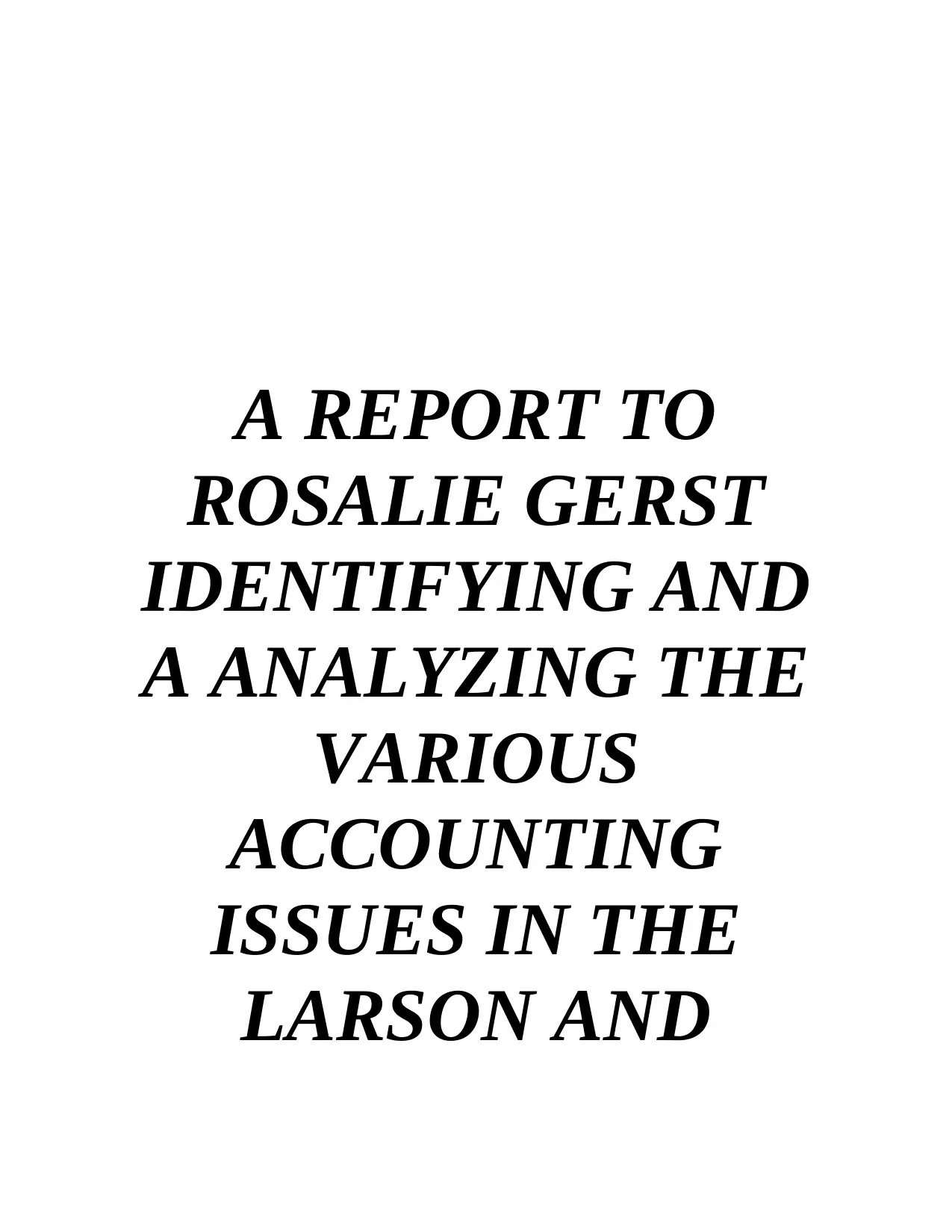
A REPORT TO
ROSALIE GERST
IDENTIFYING AND
A ANALYZING THE
VARIOUS
ACCOUNTING
ISSUES IN THE
LARSON AND
ROSALIE GERST
IDENTIFYING AND
A ANALYZING THE
VARIOUS
ACCOUNTING
ISSUES IN THE
LARSON AND
Paraphrase This Document
Need a fresh take? Get an instant paraphrase of this document with our AI Paraphraser

DYNAMIC
CONTRACT
CONTRACT
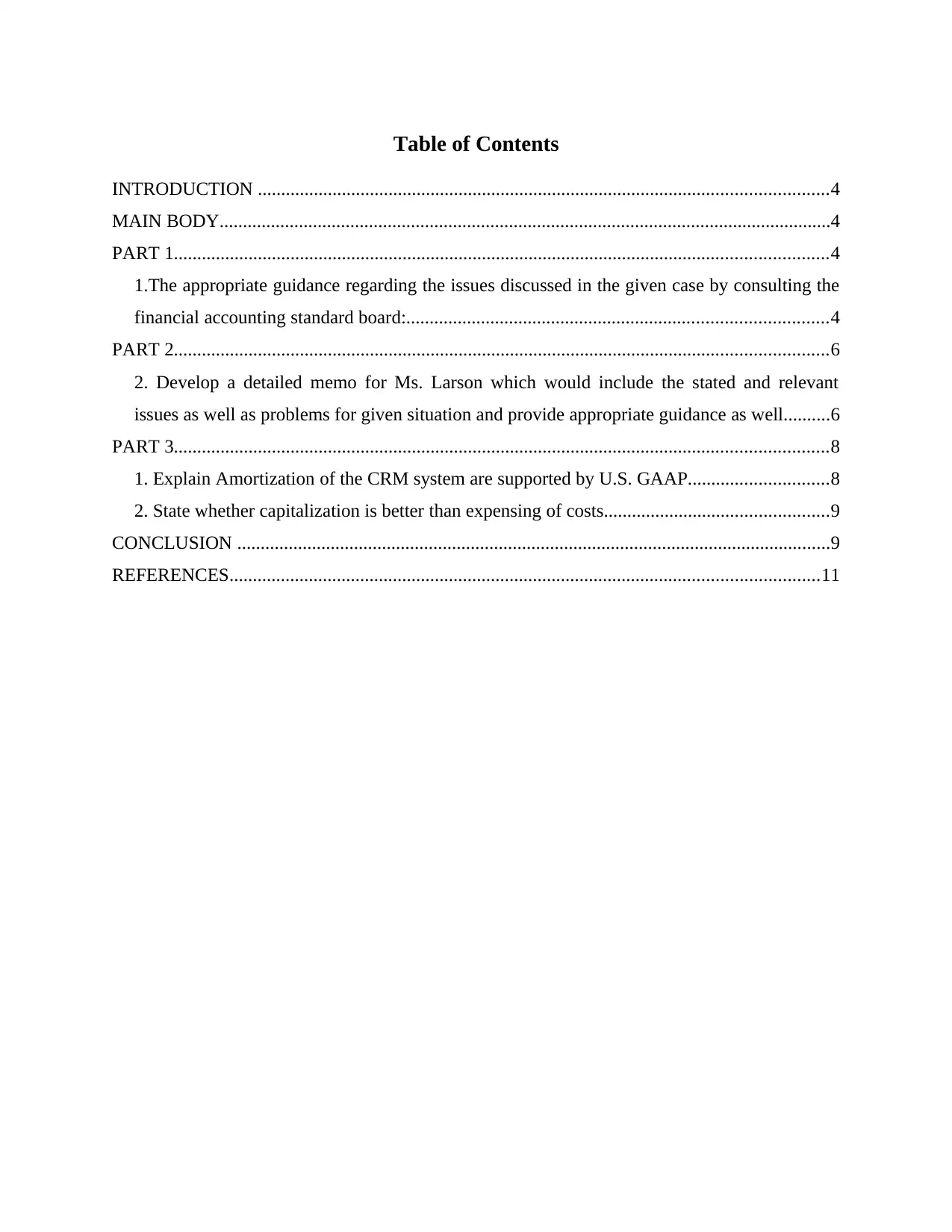
Table of Contents
INTRODUCTION ..........................................................................................................................4
MAIN BODY...................................................................................................................................4
PART 1............................................................................................................................................4
1.The appropriate guidance regarding the issues discussed in the given case by consulting the
financial accounting standard board:..........................................................................................4
PART 2............................................................................................................................................6
2. Develop a detailed memo for Ms. Larson which would include the stated and relevant
issues as well as problems for given situation and provide appropriate guidance as well..........6
PART 3............................................................................................................................................8
1. Explain Amortization of the CRM system are supported by U.S. GAAP..............................8
2. State whether capitalization is better than expensing of costs................................................9
CONCLUSION ...............................................................................................................................9
REFERENCES..............................................................................................................................11
INTRODUCTION ..........................................................................................................................4
MAIN BODY...................................................................................................................................4
PART 1............................................................................................................................................4
1.The appropriate guidance regarding the issues discussed in the given case by consulting the
financial accounting standard board:..........................................................................................4
PART 2............................................................................................................................................6
2. Develop a detailed memo for Ms. Larson which would include the stated and relevant
issues as well as problems for given situation and provide appropriate guidance as well..........6
PART 3............................................................................................................................................8
1. Explain Amortization of the CRM system are supported by U.S. GAAP..............................8
2. State whether capitalization is better than expensing of costs................................................9
CONCLUSION ...............................................................................................................................9
REFERENCES..............................................................................................................................11
⊘ This is a preview!⊘
Do you want full access?
Subscribe today to unlock all pages.

Trusted by 1+ million students worldwide
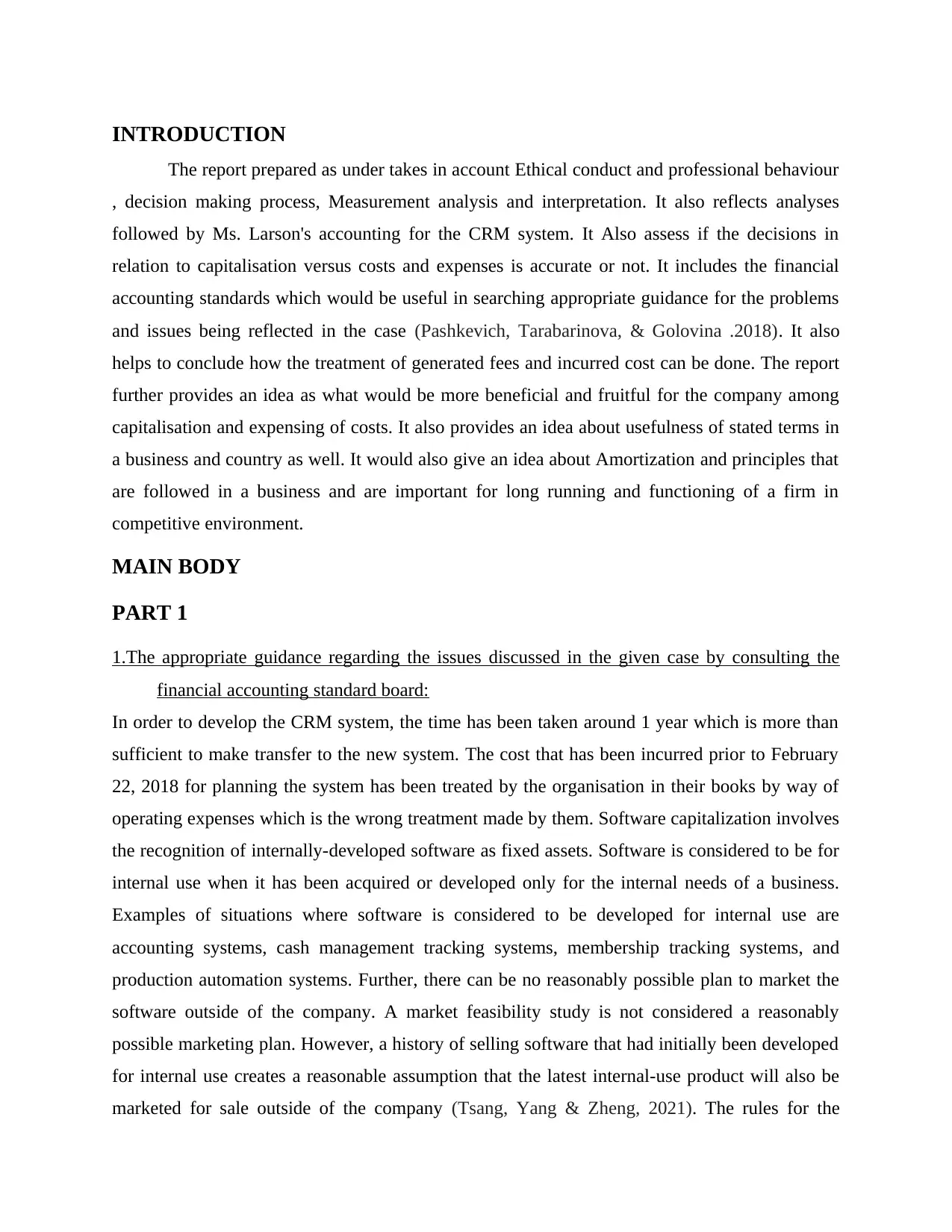
INTRODUCTION
The report prepared as under takes in account Ethical conduct and professional behaviour
, decision making process, Measurement analysis and interpretation. It also reflects analyses
followed by Ms. Larson's accounting for the CRM system. It Also assess if the decisions in
relation to capitalisation versus costs and expenses is accurate or not. It includes the financial
accounting standards which would be useful in searching appropriate guidance for the problems
and issues being reflected in the case (Pashkevich, Tarabarinova, & Golovina .2018). It also
helps to conclude how the treatment of generated fees and incurred cost can be done. The report
further provides an idea as what would be more beneficial and fruitful for the company among
capitalisation and expensing of costs. It also provides an idea about usefulness of stated terms in
a business and country as well. It would also give an idea about Amortization and principles that
are followed in a business and are important for long running and functioning of a firm in
competitive environment.
MAIN BODY
PART 1
1.The appropriate guidance regarding the issues discussed in the given case by consulting the
financial accounting standard board:
In order to develop the CRM system, the time has been taken around 1 year which is more than
sufficient to make transfer to the new system. The cost that has been incurred prior to February
22, 2018 for planning the system has been treated by the organisation in their books by way of
operating expenses which is the wrong treatment made by them. Software capitalization involves
the recognition of internally-developed software as fixed assets. Software is considered to be for
internal use when it has been acquired or developed only for the internal needs of a business.
Examples of situations where software is considered to be developed for internal use are
accounting systems, cash management tracking systems, membership tracking systems, and
production automation systems. Further, there can be no reasonably possible plan to market the
software outside of the company. A market feasibility study is not considered a reasonably
possible marketing plan. However, a history of selling software that had initially been developed
for internal use creates a reasonable assumption that the latest internal-use product will also be
marketed for sale outside of the company (Tsang, Yang & Zheng, 2021). The rules for the
The report prepared as under takes in account Ethical conduct and professional behaviour
, decision making process, Measurement analysis and interpretation. It also reflects analyses
followed by Ms. Larson's accounting for the CRM system. It Also assess if the decisions in
relation to capitalisation versus costs and expenses is accurate or not. It includes the financial
accounting standards which would be useful in searching appropriate guidance for the problems
and issues being reflected in the case (Pashkevich, Tarabarinova, & Golovina .2018). It also
helps to conclude how the treatment of generated fees and incurred cost can be done. The report
further provides an idea as what would be more beneficial and fruitful for the company among
capitalisation and expensing of costs. It also provides an idea about usefulness of stated terms in
a business and country as well. It would also give an idea about Amortization and principles that
are followed in a business and are important for long running and functioning of a firm in
competitive environment.
MAIN BODY
PART 1
1.The appropriate guidance regarding the issues discussed in the given case by consulting the
financial accounting standard board:
In order to develop the CRM system, the time has been taken around 1 year which is more than
sufficient to make transfer to the new system. The cost that has been incurred prior to February
22, 2018 for planning the system has been treated by the organisation in their books by way of
operating expenses which is the wrong treatment made by them. Software capitalization involves
the recognition of internally-developed software as fixed assets. Software is considered to be for
internal use when it has been acquired or developed only for the internal needs of a business.
Examples of situations where software is considered to be developed for internal use are
accounting systems, cash management tracking systems, membership tracking systems, and
production automation systems. Further, there can be no reasonably possible plan to market the
software outside of the company. A market feasibility study is not considered a reasonably
possible marketing plan. However, a history of selling software that had initially been developed
for internal use creates a reasonable assumption that the latest internal-use product will also be
marketed for sale outside of the company (Tsang, Yang & Zheng, 2021). The rules for the
Paraphrase This Document
Need a fresh take? Get an instant paraphrase of this document with our AI Paraphraser
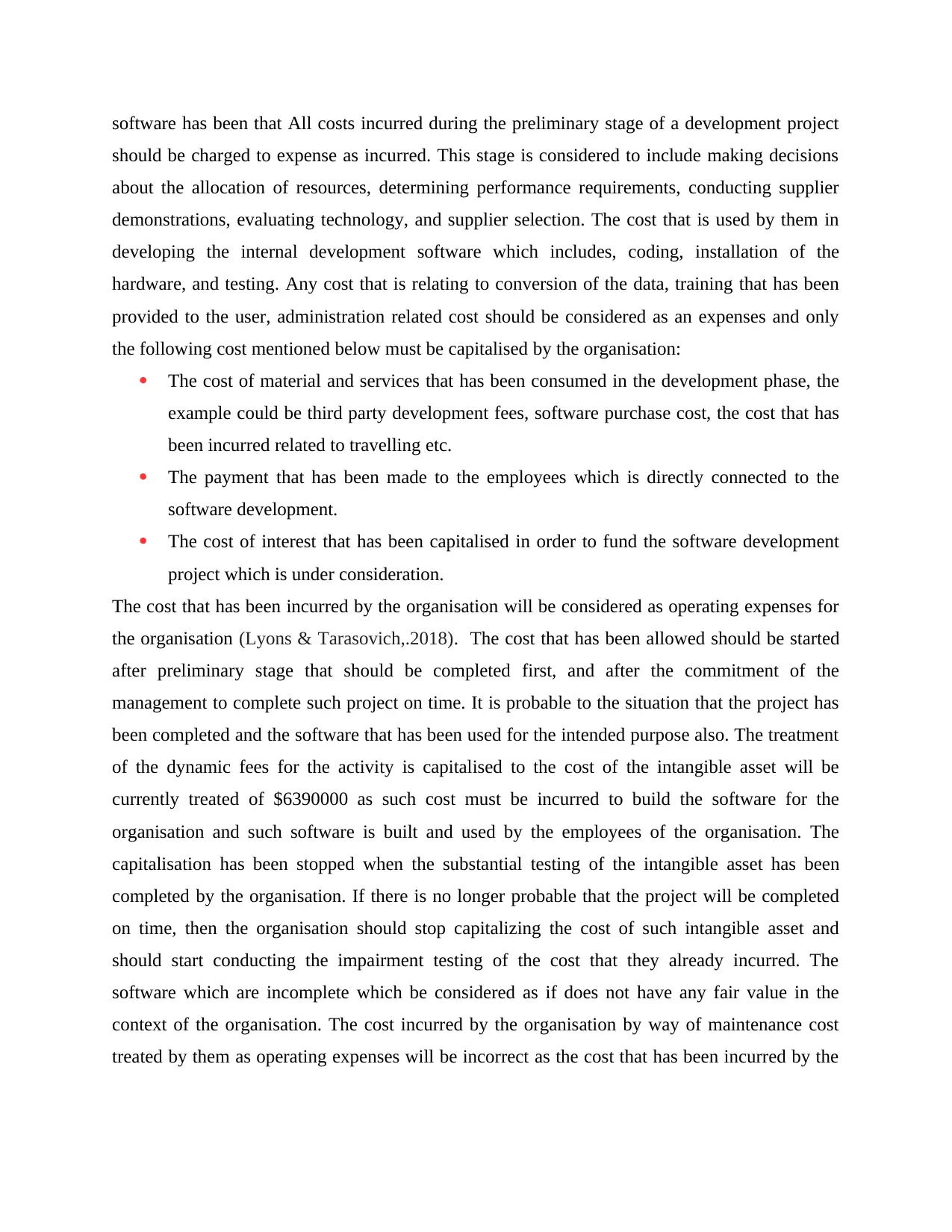
software has been that All costs incurred during the preliminary stage of a development project
should be charged to expense as incurred. This stage is considered to include making decisions
about the allocation of resources, determining performance requirements, conducting supplier
demonstrations, evaluating technology, and supplier selection. The cost that is used by them in
developing the internal development software which includes, coding, installation of the
hardware, and testing. Any cost that is relating to conversion of the data, training that has been
provided to the user, administration related cost should be considered as an expenses and only
the following cost mentioned below must be capitalised by the organisation:
The cost of material and services that has been consumed in the development phase, the
example could be third party development fees, software purchase cost, the cost that has
been incurred related to travelling etc.
The payment that has been made to the employees which is directly connected to the
software development.
The cost of interest that has been capitalised in order to fund the software development
project which is under consideration.
The cost that has been incurred by the organisation will be considered as operating expenses for
the organisation (Lyons & Tarasovich,.2018). The cost that has been allowed should be started
after preliminary stage that should be completed first, and after the commitment of the
management to complete such project on time. It is probable to the situation that the project has
been completed and the software that has been used for the intended purpose also. The treatment
of the dynamic fees for the activity is capitalised to the cost of the intangible asset will be
currently treated of $6390000 as such cost must be incurred to build the software for the
organisation and such software is built and used by the employees of the organisation. The
capitalisation has been stopped when the substantial testing of the intangible asset has been
completed by the organisation. If there is no longer probable that the project will be completed
on time, then the organisation should stop capitalizing the cost of such intangible asset and
should start conducting the impairment testing of the cost that they already incurred. The
software which are incomplete which be considered as if does not have any fair value in the
context of the organisation. The cost incurred by the organisation by way of maintenance cost
treated by them as operating expenses will be incorrect as the cost that has been incurred by the
should be charged to expense as incurred. This stage is considered to include making decisions
about the allocation of resources, determining performance requirements, conducting supplier
demonstrations, evaluating technology, and supplier selection. The cost that is used by them in
developing the internal development software which includes, coding, installation of the
hardware, and testing. Any cost that is relating to conversion of the data, training that has been
provided to the user, administration related cost should be considered as an expenses and only
the following cost mentioned below must be capitalised by the organisation:
The cost of material and services that has been consumed in the development phase, the
example could be third party development fees, software purchase cost, the cost that has
been incurred related to travelling etc.
The payment that has been made to the employees which is directly connected to the
software development.
The cost of interest that has been capitalised in order to fund the software development
project which is under consideration.
The cost that has been incurred by the organisation will be considered as operating expenses for
the organisation (Lyons & Tarasovich,.2018). The cost that has been allowed should be started
after preliminary stage that should be completed first, and after the commitment of the
management to complete such project on time. It is probable to the situation that the project has
been completed and the software that has been used for the intended purpose also. The treatment
of the dynamic fees for the activity is capitalised to the cost of the intangible asset will be
currently treated of $6390000 as such cost must be incurred to build the software for the
organisation and such software is built and used by the employees of the organisation. The
capitalisation has been stopped when the substantial testing of the intangible asset has been
completed by the organisation. If there is no longer probable that the project will be completed
on time, then the organisation should stop capitalizing the cost of such intangible asset and
should start conducting the impairment testing of the cost that they already incurred. The
software which are incomplete which be considered as if does not have any fair value in the
context of the organisation. The cost incurred by the organisation by way of maintenance cost
treated by them as operating expenses will be incorrect as the cost that has been incurred by the
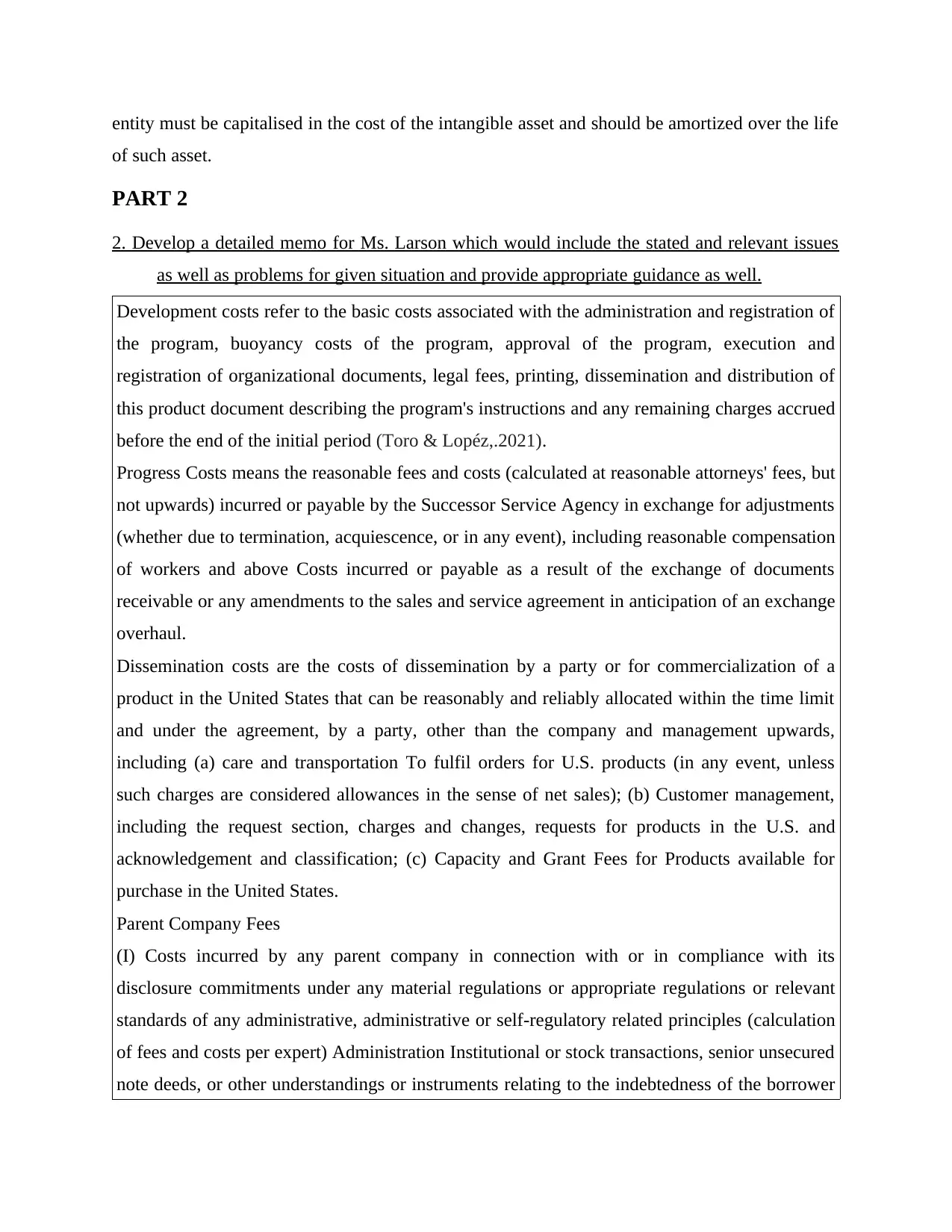
entity must be capitalised in the cost of the intangible asset and should be amortized over the life
of such asset.
PART 2
2. Develop a detailed memo for Ms. Larson which would include the stated and relevant issues
as well as problems for given situation and provide appropriate guidance as well.
Development costs refer to the basic costs associated with the administration and registration of
the program, buoyancy costs of the program, approval of the program, execution and
registration of organizational documents, legal fees, printing, dissemination and distribution of
this product document describing the program's instructions and any remaining charges accrued
before the end of the initial period (Toro & Lopéz,.2021).
Progress Costs means the reasonable fees and costs (calculated at reasonable attorneys' fees, but
not upwards) incurred or payable by the Successor Service Agency in exchange for adjustments
(whether due to termination, acquiescence, or in any event), including reasonable compensation
of workers and above Costs incurred or payable as a result of the exchange of documents
receivable or any amendments to the sales and service agreement in anticipation of an exchange
overhaul.
Dissemination costs are the costs of dissemination by a party or for commercialization of a
product in the United States that can be reasonably and reliably allocated within the time limit
and under the agreement, by a party, other than the company and management upwards,
including (a) care and transportation To fulfil orders for U.S. products (in any event, unless
such charges are considered allowances in the sense of net sales); (b) Customer management,
including the request section, charges and changes, requests for products in the U.S. and
acknowledgement and classification; (c) Capacity and Grant Fees for Products available for
purchase in the United States.
Parent Company Fees
(I) Costs incurred by any parent company in connection with or in compliance with its
disclosure commitments under any material regulations or appropriate regulations or relevant
standards of any administrative, administrative or self-regulatory related principles (calculation
of fees and costs per expert) Administration Institutional or stock transactions, senior unsecured
note deeds, or other understandings or instruments relating to the indebtedness of the borrower
of such asset.
PART 2
2. Develop a detailed memo for Ms. Larson which would include the stated and relevant issues
as well as problems for given situation and provide appropriate guidance as well.
Development costs refer to the basic costs associated with the administration and registration of
the program, buoyancy costs of the program, approval of the program, execution and
registration of organizational documents, legal fees, printing, dissemination and distribution of
this product document describing the program's instructions and any remaining charges accrued
before the end of the initial period (Toro & Lopéz,.2021).
Progress Costs means the reasonable fees and costs (calculated at reasonable attorneys' fees, but
not upwards) incurred or payable by the Successor Service Agency in exchange for adjustments
(whether due to termination, acquiescence, or in any event), including reasonable compensation
of workers and above Costs incurred or payable as a result of the exchange of documents
receivable or any amendments to the sales and service agreement in anticipation of an exchange
overhaul.
Dissemination costs are the costs of dissemination by a party or for commercialization of a
product in the United States that can be reasonably and reliably allocated within the time limit
and under the agreement, by a party, other than the company and management upwards,
including (a) care and transportation To fulfil orders for U.S. products (in any event, unless
such charges are considered allowances in the sense of net sales); (b) Customer management,
including the request section, charges and changes, requests for products in the U.S. and
acknowledgement and classification; (c) Capacity and Grant Fees for Products available for
purchase in the United States.
Parent Company Fees
(I) Costs incurred by any parent company in connection with or in compliance with its
disclosure commitments under any material regulations or appropriate regulations or relevant
standards of any administrative, administrative or self-regulatory related principles (calculation
of fees and costs per expert) Administration Institutional or stock transactions, senior unsecured
note deeds, or other understandings or instruments relating to the indebtedness of the borrower
⊘ This is a preview!⊘
Do you want full access?
Subscribe today to unlock all pages.

Trusted by 1+ million students worldwide
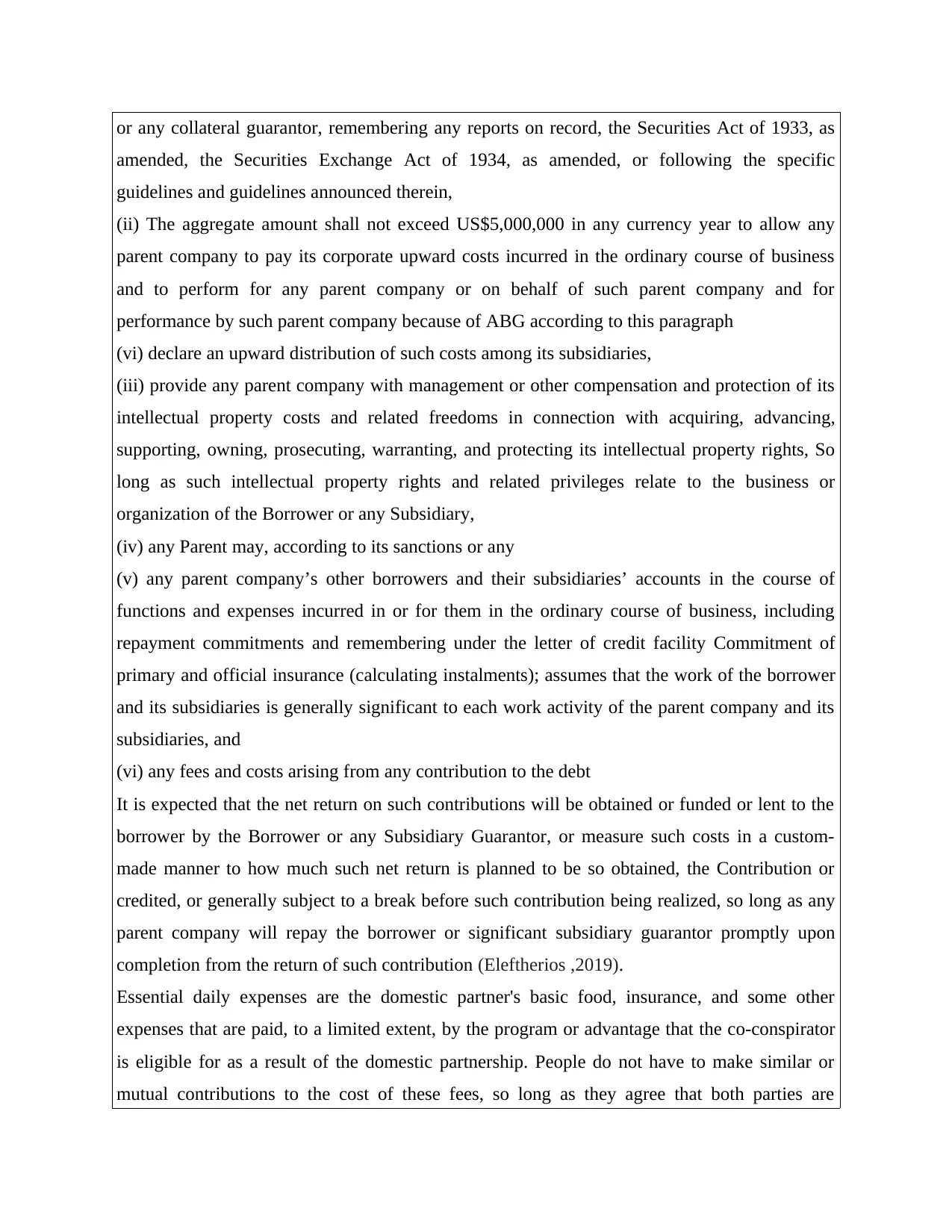
or any collateral guarantor, remembering any reports on record, the Securities Act of 1933, as
amended, the Securities Exchange Act of 1934, as amended, or following the specific
guidelines and guidelines announced therein,
(ii) The aggregate amount shall not exceed US$5,000,000 in any currency year to allow any
parent company to pay its corporate upward costs incurred in the ordinary course of business
and to perform for any parent company or on behalf of such parent company and for
performance by such parent company because of ABG according to this paragraph
(vi) declare an upward distribution of such costs among its subsidiaries,
(iii) provide any parent company with management or other compensation and protection of its
intellectual property costs and related freedoms in connection with acquiring, advancing,
supporting, owning, prosecuting, warranting, and protecting its intellectual property rights, So
long as such intellectual property rights and related privileges relate to the business or
organization of the Borrower or any Subsidiary,
(iv) any Parent may, according to its sanctions or any
(v) any parent company’s other borrowers and their subsidiaries’ accounts in the course of
functions and expenses incurred in or for them in the ordinary course of business, including
repayment commitments and remembering under the letter of credit facility Commitment of
primary and official insurance (calculating instalments); assumes that the work of the borrower
and its subsidiaries is generally significant to each work activity of the parent company and its
subsidiaries, and
(vi) any fees and costs arising from any contribution to the debt
It is expected that the net return on such contributions will be obtained or funded or lent to the
borrower by the Borrower or any Subsidiary Guarantor, or measure such costs in a custom-
made manner to how much such net return is planned to be so obtained, the Contribution or
credited, or generally subject to a break before such contribution being realized, so long as any
parent company will repay the borrower or significant subsidiary guarantor promptly upon
completion from the return of such contribution (Eleftherios ,2019).
Essential daily expenses are the domestic partner's basic food, insurance, and some other
expenses that are paid, to a limited extent, by the program or advantage that the co-conspirator
is eligible for as a result of the domestic partnership. People do not have to make similar or
mutual contributions to the cost of these fees, so long as they agree that both parties are
amended, the Securities Exchange Act of 1934, as amended, or following the specific
guidelines and guidelines announced therein,
(ii) The aggregate amount shall not exceed US$5,000,000 in any currency year to allow any
parent company to pay its corporate upward costs incurred in the ordinary course of business
and to perform for any parent company or on behalf of such parent company and for
performance by such parent company because of ABG according to this paragraph
(vi) declare an upward distribution of such costs among its subsidiaries,
(iii) provide any parent company with management or other compensation and protection of its
intellectual property costs and related freedoms in connection with acquiring, advancing,
supporting, owning, prosecuting, warranting, and protecting its intellectual property rights, So
long as such intellectual property rights and related privileges relate to the business or
organization of the Borrower or any Subsidiary,
(iv) any Parent may, according to its sanctions or any
(v) any parent company’s other borrowers and their subsidiaries’ accounts in the course of
functions and expenses incurred in or for them in the ordinary course of business, including
repayment commitments and remembering under the letter of credit facility Commitment of
primary and official insurance (calculating instalments); assumes that the work of the borrower
and its subsidiaries is generally significant to each work activity of the parent company and its
subsidiaries, and
(vi) any fees and costs arising from any contribution to the debt
It is expected that the net return on such contributions will be obtained or funded or lent to the
borrower by the Borrower or any Subsidiary Guarantor, or measure such costs in a custom-
made manner to how much such net return is planned to be so obtained, the Contribution or
credited, or generally subject to a break before such contribution being realized, so long as any
parent company will repay the borrower or significant subsidiary guarantor promptly upon
completion from the return of such contribution (Eleftherios ,2019).
Essential daily expenses are the domestic partner's basic food, insurance, and some other
expenses that are paid, to a limited extent, by the program or advantage that the co-conspirator
is eligible for as a result of the domestic partnership. People do not have to make similar or
mutual contributions to the cost of these fees, so long as they agree that both parties are
Paraphrase This Document
Need a fresh take? Get an instant paraphrase of this document with our AI Paraphraser
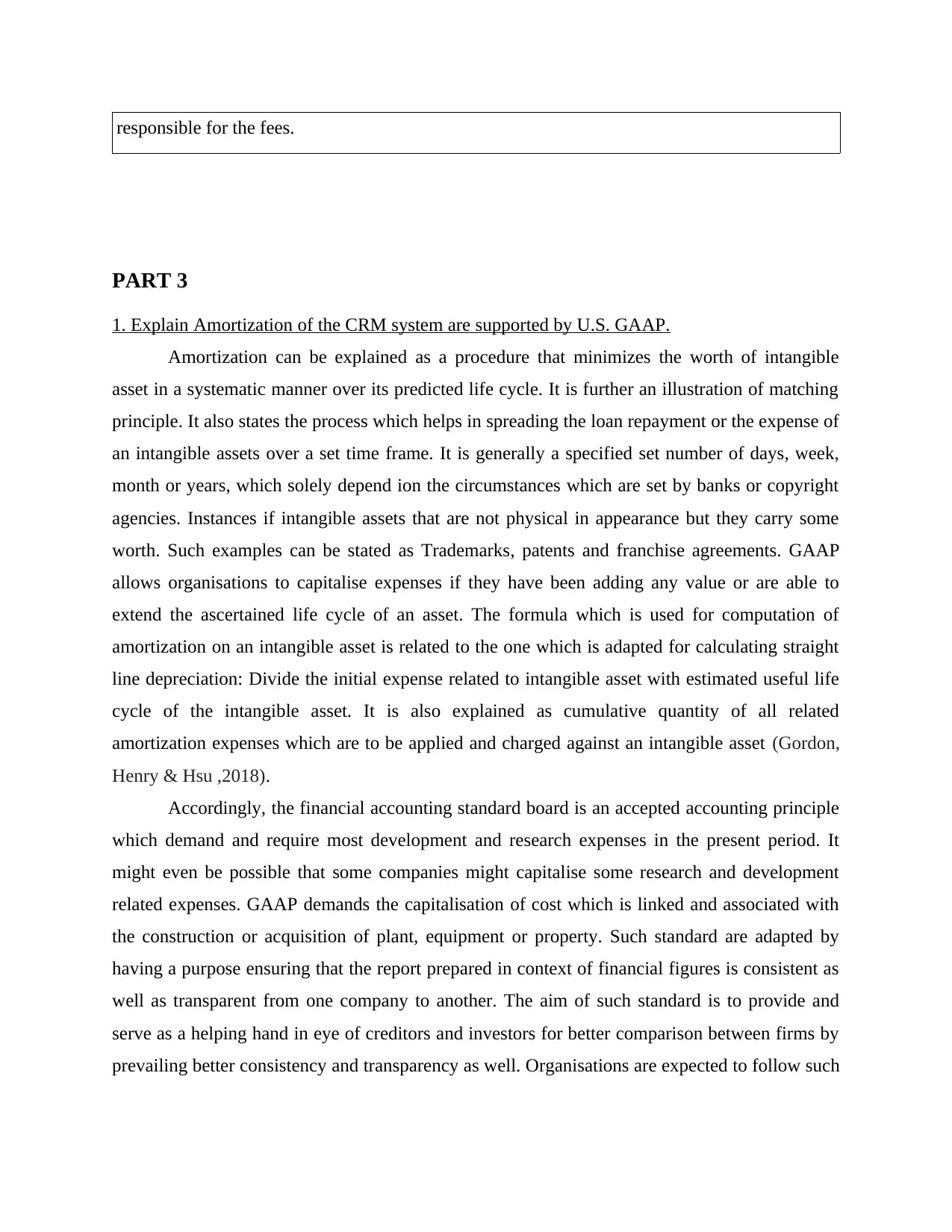
responsible for the fees.
PART 3
1. Explain Amortization of the CRM system are supported by U.S. GAAP.
Amortization can be explained as a procedure that minimizes the worth of intangible
asset in a systematic manner over its predicted life cycle. It is further an illustration of matching
principle. It also states the process which helps in spreading the loan repayment or the expense of
an intangible assets over a set time frame. It is generally a specified set number of days, week,
month or years, which solely depend ion the circumstances which are set by banks or copyright
agencies. Instances if intangible assets that are not physical in appearance but they carry some
worth. Such examples can be stated as Trademarks, patents and franchise agreements. GAAP
allows organisations to capitalise expenses if they have been adding any value or are able to
extend the ascertained life cycle of an asset. The formula which is used for computation of
amortization on an intangible asset is related to the one which is adapted for calculating straight
line depreciation: Divide the initial expense related to intangible asset with estimated useful life
cycle of the intangible asset. It is also explained as cumulative quantity of all related
amortization expenses which are to be applied and charged against an intangible asset (Gordon,
Henry & Hsu ,2018).
Accordingly, the financial accounting standard board is an accepted accounting principle
which demand and require most development and research expenses in the present period. It
might even be possible that some companies might capitalise some research and development
related expenses. GAAP demands the capitalisation of cost which is linked and associated with
the construction or acquisition of plant, equipment or property. Such standard are adapted by
having a purpose ensuring that the report prepared in context of financial figures is consistent as
well as transparent from one company to another. The aim of such standard is to provide and
serve as a helping hand in eye of creditors and investors for better comparison between firms by
prevailing better consistency and transparency as well. Organisations are expected to follow such
PART 3
1. Explain Amortization of the CRM system are supported by U.S. GAAP.
Amortization can be explained as a procedure that minimizes the worth of intangible
asset in a systematic manner over its predicted life cycle. It is further an illustration of matching
principle. It also states the process which helps in spreading the loan repayment or the expense of
an intangible assets over a set time frame. It is generally a specified set number of days, week,
month or years, which solely depend ion the circumstances which are set by banks or copyright
agencies. Instances if intangible assets that are not physical in appearance but they carry some
worth. Such examples can be stated as Trademarks, patents and franchise agreements. GAAP
allows organisations to capitalise expenses if they have been adding any value or are able to
extend the ascertained life cycle of an asset. The formula which is used for computation of
amortization on an intangible asset is related to the one which is adapted for calculating straight
line depreciation: Divide the initial expense related to intangible asset with estimated useful life
cycle of the intangible asset. It is also explained as cumulative quantity of all related
amortization expenses which are to be applied and charged against an intangible asset (Gordon,
Henry & Hsu ,2018).
Accordingly, the financial accounting standard board is an accepted accounting principle
which demand and require most development and research expenses in the present period. It
might even be possible that some companies might capitalise some research and development
related expenses. GAAP demands the capitalisation of cost which is linked and associated with
the construction or acquisition of plant, equipment or property. Such standard are adapted by
having a purpose ensuring that the report prepared in context of financial figures is consistent as
well as transparent from one company to another. The aim of such standard is to provide and
serve as a helping hand in eye of creditors and investors for better comparison between firms by
prevailing better consistency and transparency as well. Organisations are expected to follow such
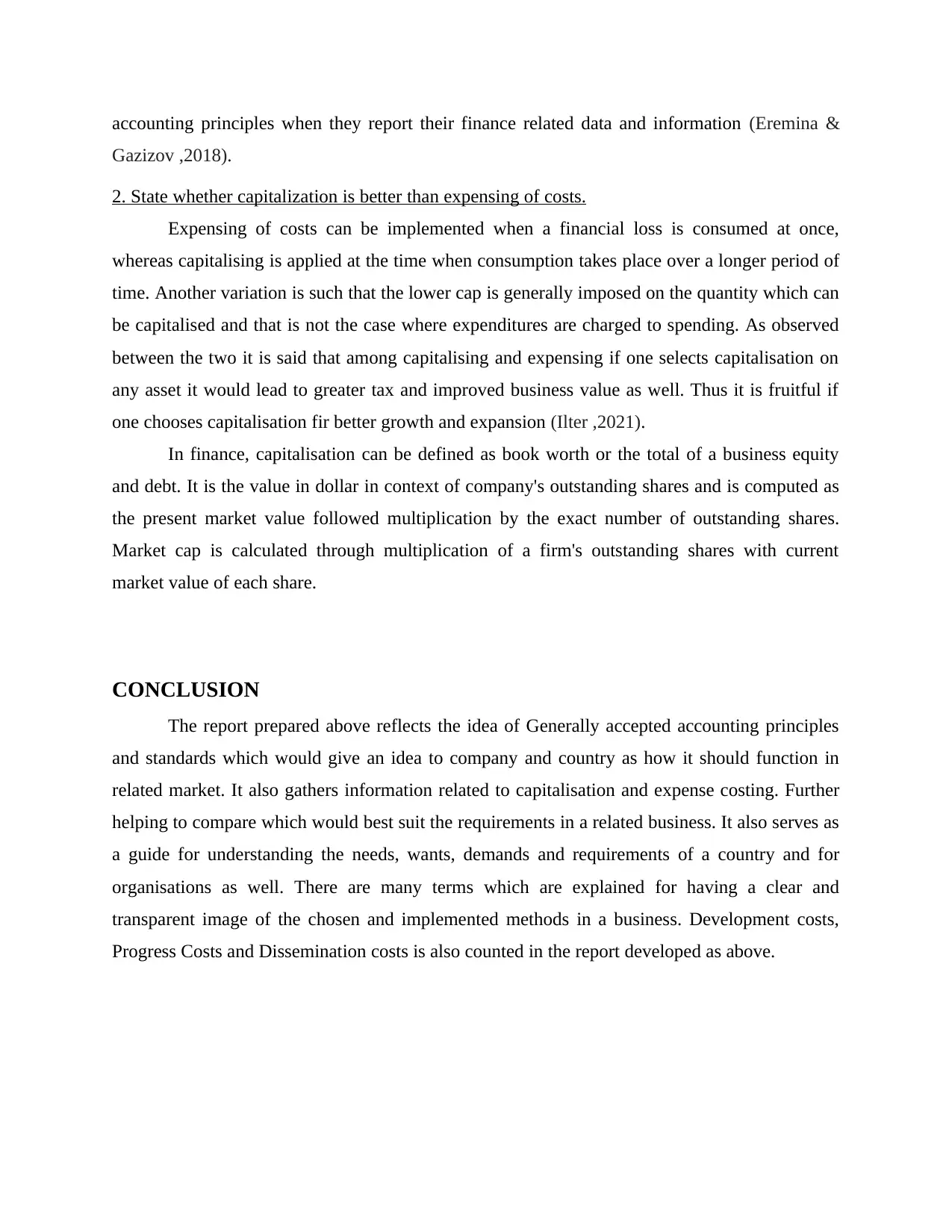
accounting principles when they report their finance related data and information (Eremina &
Gazizov ,2018).
2. State whether capitalization is better than expensing of costs.
Expensing of costs can be implemented when a financial loss is consumed at once,
whereas capitalising is applied at the time when consumption takes place over a longer period of
time. Another variation is such that the lower cap is generally imposed on the quantity which can
be capitalised and that is not the case where expenditures are charged to spending. As observed
between the two it is said that among capitalising and expensing if one selects capitalisation on
any asset it would lead to greater tax and improved business value as well. Thus it is fruitful if
one chooses capitalisation fir better growth and expansion (Ilter ,2021).
In finance, capitalisation can be defined as book worth or the total of a business equity
and debt. It is the value in dollar in context of company's outstanding shares and is computed as
the present market value followed multiplication by the exact number of outstanding shares.
Market cap is calculated through multiplication of a firm's outstanding shares with current
market value of each share.
CONCLUSION
The report prepared above reflects the idea of Generally accepted accounting principles
and standards which would give an idea to company and country as how it should function in
related market. It also gathers information related to capitalisation and expense costing. Further
helping to compare which would best suit the requirements in a related business. It also serves as
a guide for understanding the needs, wants, demands and requirements of a country and for
organisations as well. There are many terms which are explained for having a clear and
transparent image of the chosen and implemented methods in a business. Development costs,
Progress Costs and Dissemination costs is also counted in the report developed as above.
Gazizov ,2018).
2. State whether capitalization is better than expensing of costs.
Expensing of costs can be implemented when a financial loss is consumed at once,
whereas capitalising is applied at the time when consumption takes place over a longer period of
time. Another variation is such that the lower cap is generally imposed on the quantity which can
be capitalised and that is not the case where expenditures are charged to spending. As observed
between the two it is said that among capitalising and expensing if one selects capitalisation on
any asset it would lead to greater tax and improved business value as well. Thus it is fruitful if
one chooses capitalisation fir better growth and expansion (Ilter ,2021).
In finance, capitalisation can be defined as book worth or the total of a business equity
and debt. It is the value in dollar in context of company's outstanding shares and is computed as
the present market value followed multiplication by the exact number of outstanding shares.
Market cap is calculated through multiplication of a firm's outstanding shares with current
market value of each share.
CONCLUSION
The report prepared above reflects the idea of Generally accepted accounting principles
and standards which would give an idea to company and country as how it should function in
related market. It also gathers information related to capitalisation and expense costing. Further
helping to compare which would best suit the requirements in a related business. It also serves as
a guide for understanding the needs, wants, demands and requirements of a country and for
organisations as well. There are many terms which are explained for having a clear and
transparent image of the chosen and implemented methods in a business. Development costs,
Progress Costs and Dissemination costs is also counted in the report developed as above.
⊘ This is a preview!⊘
Do you want full access?
Subscribe today to unlock all pages.

Trusted by 1+ million students worldwide

Paraphrase This Document
Need a fresh take? Get an instant paraphrase of this document with our AI Paraphraser
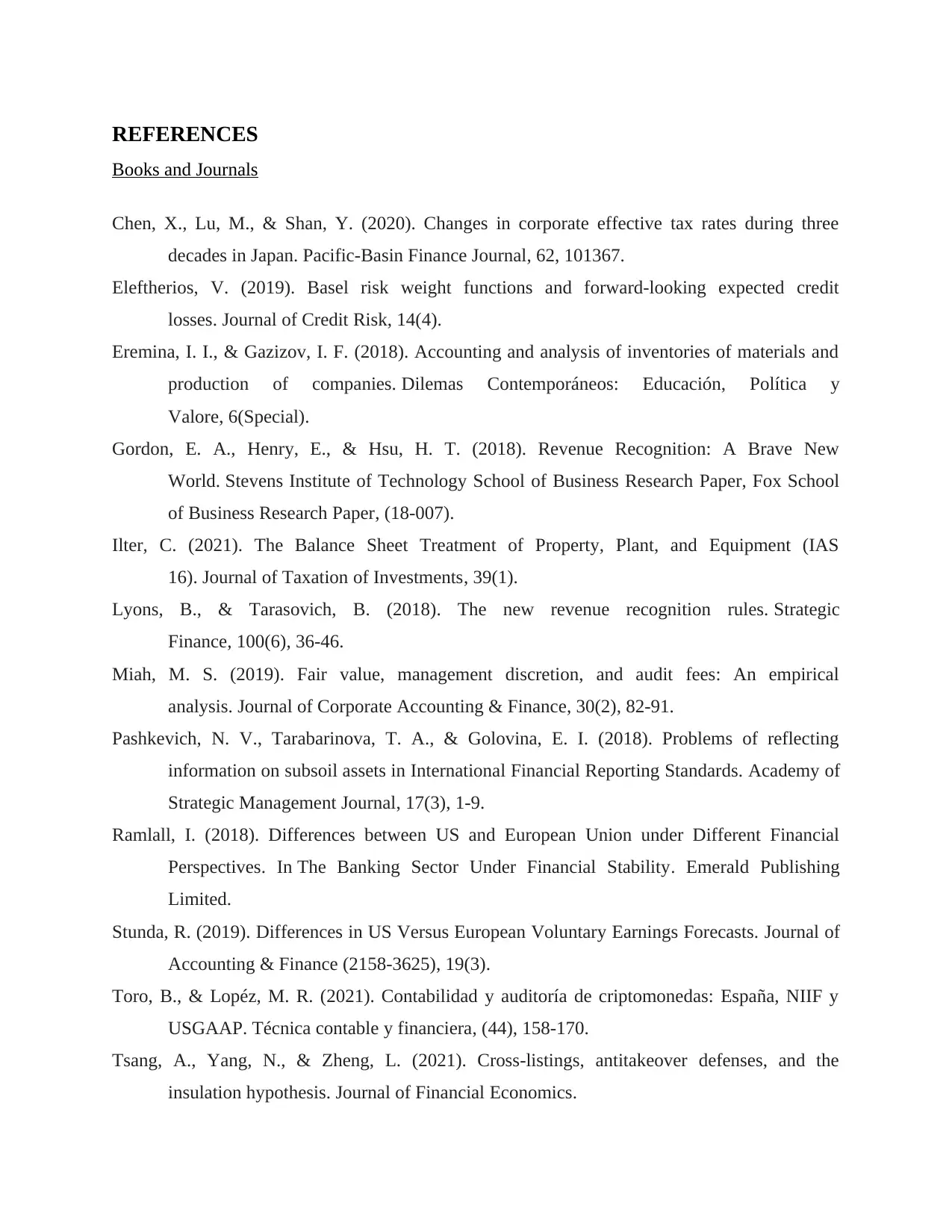
REFERENCES
Books and Journals
Chen, X., Lu, M., & Shan, Y. (2020). Changes in corporate effective tax rates during three
decades in Japan. Pacific-Basin Finance Journal, 62, 101367.
Eleftherios, V. (2019). Basel risk weight functions and forward-looking expected credit
losses. Journal of Credit Risk, 14(4).
Eremina, I. I., & Gazizov, I. F. (2018). Accounting and analysis of inventories of materials and
production of companies. Dilemas Contemporáneos: Educación, Política y
Valore, 6(Special).
Gordon, E. A., Henry, E., & Hsu, H. T. (2018). Revenue Recognition: A Brave New
World. Stevens Institute of Technology School of Business Research Paper, Fox School
of Business Research Paper, (18-007).
Ilter, C. (2021). The Balance Sheet Treatment of Property, Plant, and Equipment (IAS
16). Journal of Taxation of Investments, 39(1).
Lyons, B., & Tarasovich, B. (2018). The new revenue recognition rules. Strategic
Finance, 100(6), 36-46.
Miah, M. S. (2019). Fair value, management discretion, and audit fees: An empirical
analysis. Journal of Corporate Accounting & Finance, 30(2), 82-91.
Pashkevich, N. V., Tarabarinova, T. A., & Golovina, E. I. (2018). Problems of reflecting
information on subsoil assets in International Financial Reporting Standards. Academy of
Strategic Management Journal, 17(3), 1-9.
Ramlall, I. (2018). Differences between US and European Union under Different Financial
Perspectives. In The Banking Sector Under Financial Stability. Emerald Publishing
Limited.
Stunda, R. (2019). Differences in US Versus European Voluntary Earnings Forecasts. Journal of
Accounting & Finance (2158-3625), 19(3).
Toro, B., & Lopéz, M. R. (2021). Contabilidad y auditoría de criptomonedas: España, NIIF y
USGAAP. Técnica contable y financiera, (44), 158-170.
Tsang, A., Yang, N., & Zheng, L. (2021). Cross-listings, antitakeover defenses, and the
insulation hypothesis. Journal of Financial Economics.
Books and Journals
Chen, X., Lu, M., & Shan, Y. (2020). Changes in corporate effective tax rates during three
decades in Japan. Pacific-Basin Finance Journal, 62, 101367.
Eleftherios, V. (2019). Basel risk weight functions and forward-looking expected credit
losses. Journal of Credit Risk, 14(4).
Eremina, I. I., & Gazizov, I. F. (2018). Accounting and analysis of inventories of materials and
production of companies. Dilemas Contemporáneos: Educación, Política y
Valore, 6(Special).
Gordon, E. A., Henry, E., & Hsu, H. T. (2018). Revenue Recognition: A Brave New
World. Stevens Institute of Technology School of Business Research Paper, Fox School
of Business Research Paper, (18-007).
Ilter, C. (2021). The Balance Sheet Treatment of Property, Plant, and Equipment (IAS
16). Journal of Taxation of Investments, 39(1).
Lyons, B., & Tarasovich, B. (2018). The new revenue recognition rules. Strategic
Finance, 100(6), 36-46.
Miah, M. S. (2019). Fair value, management discretion, and audit fees: An empirical
analysis. Journal of Corporate Accounting & Finance, 30(2), 82-91.
Pashkevich, N. V., Tarabarinova, T. A., & Golovina, E. I. (2018). Problems of reflecting
information on subsoil assets in International Financial Reporting Standards. Academy of
Strategic Management Journal, 17(3), 1-9.
Ramlall, I. (2018). Differences between US and European Union under Different Financial
Perspectives. In The Banking Sector Under Financial Stability. Emerald Publishing
Limited.
Stunda, R. (2019). Differences in US Versus European Voluntary Earnings Forecasts. Journal of
Accounting & Finance (2158-3625), 19(3).
Toro, B., & Lopéz, M. R. (2021). Contabilidad y auditoría de criptomonedas: España, NIIF y
USGAAP. Técnica contable y financiera, (44), 158-170.
Tsang, A., Yang, N., & Zheng, L. (2021). Cross-listings, antitakeover defenses, and the
insulation hypothesis. Journal of Financial Economics.

⊘ This is a preview!⊘
Do you want full access?
Subscribe today to unlock all pages.

Trusted by 1+ million students worldwide
1 out of 14
Related Documents
Your All-in-One AI-Powered Toolkit for Academic Success.
+13062052269
info@desklib.com
Available 24*7 on WhatsApp / Email
![[object Object]](/_next/static/media/star-bottom.7253800d.svg)
Unlock your academic potential
Copyright © 2020–2025 A2Z Services. All Rights Reserved. Developed and managed by ZUCOL.




